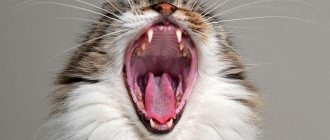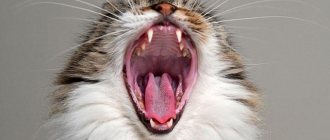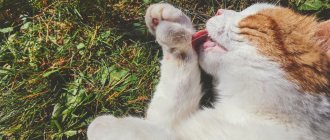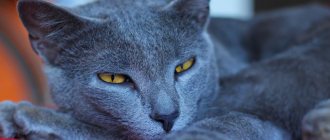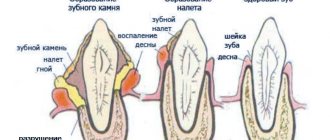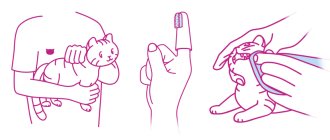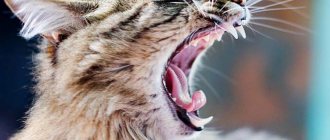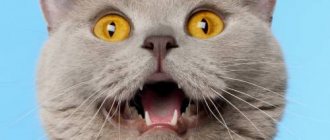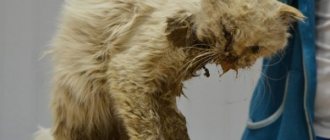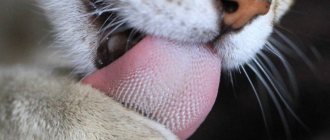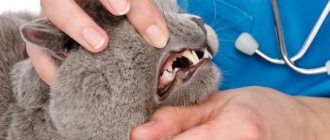The Murkoshi team will tell you how to determine that a cat has toothache, what diseases there are in the oral cavity, and how to help your pet in this situation. It turns out that cats, like people, have many oral diseases: caries, osteomyelitis, periodontitis, gingivitis and much more. You can learn about all this in detail in this article.
1) How to determine that a cat has toothache
2) Causes of dental diseases
3) Why does a kitten’s teeth hurt?
4) Symptoms of diseased teeth
5) Dental treatment
6) Prevention of dental diseases in kittens
How to tell if your cat has toothache
Toothache for cats is not only an unpleasant sensation, but also a risk factor for the occurrence of other, more serious diseases of organs and body systems. Therefore, it is very important to monitor the oral health of your beloved pets.
It is not difficult to identify toothache in an animal. Firstly, a cat with bad teeth eats slowly, carefully and with extreme caution. In addition, the unfortunate animal may accidentally drop pieces of food from its mouth. In this state, the cat is not able to eat much. Secondly, due to severe pain, the cat may refuse to eat at all. Thirdly, if the teeth itch, the kitten may rub its muzzle against chairs or other hard furniture, making plaintive sounds.
Pulpitis
Again, it often develops as a result of advanced caries . This is the name for inflammation of the pulp, that is, the internal tissues of the tooth. It is often purulent. It is accompanied by terrible pain, from which cats literally cannot find a place for themselves, do not sleep, do not eat, rush around the room in circles, meow hoarsely and protractedly. When you try to touch a sore tooth, they hiss, break out, and can seriously bite or scratch a person.
This disease has to be treated radically and without alternative - the affected tooth is immediately removed . If it comes to pulpitis, then it is clearly impossible to save it. In addition, the cat may simply not be able to withstand severe pain - stress and exhaustion have a very bad effect on the body.
Causes of dental diseases
Cats can have many different oral diseases. Let's try to understand the characteristics of each specific ailment.
Caries
Caries in cats is not much different from caries in humans. It also has several stages. Starting from the stain stage, continuing with the formation of a carious cavity and ending with the appearance of holes and tooth destruction. This is the process of tooth decay due to poor hygiene or genetic predisposition. To alleviate the condition, at home you can irrigate your pet’s mouth with an infusion of sea buckthorn or chamomile. These herbs have anti-inflammatory effects. However, we must understand that this is only a temporary measure. To truly relieve your cat of pain, you need to contact a specialist as soon as possible.
More about caries: Do cats have caries?
Osteomyelitis
This is an inflammatory disease of the bone tissue of the teeth, which is formed as a result of untreated caries or pulpitis. This happens because suppuration appears in the gums next to the diseased tooth. Pus usually forms in a “pocket.” In this case, the animal experiences severe pain, its lymph nodes become enlarged and unusual to the touch. The disease is serious and requires mandatory treatment from a veterinarian.
Periodontitis
This is a common disease in cats due to poor hygiene. It is an inflammation of the root of a cat's tooth. It is accompanied by a strong bad breath and pronounced plaque on the teeth. Unfortunately, our feline friends cannot brush their own teeth, so it is very important that the owner remembers the hygiene of his beloved pet. Maintaining oral hygiene will help prevent the occurrence of this disease.
Read more: How to brush your cat's teeth
Gingivitis
Gingivitis in cats occurs due to rotting of remaining pieces of food in the interdental spaces, infection or metabolic disorders. In addition, you can get this disease due to a large amount of tartar. The animal's gums bleed, become covered with ulcers and other sores. By the way, at the initial stage of the disease, it can be treated with regular, high-quality home cleaning of your pet’s teeth. But you still need to consult a specialist. Only he will be able to determine the exact stage of the disease and explain how effective home treatment will be and whether it is advisable.
Read more about this disease: Symptoms and treatment of gingivitis in cats
Caries
A very well-known pathology involving putrefactive damage to the outer tissues of the tooth. It is a common consequence of both bacterial plaque and tartar. Initially, enamel is perhaps the most durable tissue in the cat’s body, but under the action of enzymes secreted in abundance by microorganisms, it gradually dissolves. Then the same enzymes begin to act on the outer tissues of the tooth, as a result of which the latter degrade, pathogenic, putrefactive microflora settles there, and the fang rots. The main symptom of this disease is the appearance of dark areas on the tooth. Since cats are rarely delighted with a dental examination, this should only be done when the animal is under anesthesia.
Alas, in cats, as a rule, caries is detected only in the final stages, when it is almost impossible to do anything to save the tooth. So the affected tissue is removed... along with the tooth itself. Only in rare cases, when the process was diagnosed at the initial stage, is it possible to grind off the affected areas and cover these areas with a protective composition. Moreover, the latter must be done without fail. The layer of enamel on cat teeth is very thin (compared to human teeth), since these animals do not need to chew their food particularly hard. So, with the slightest damage, their teeth rot and break down at an alarming rate.
Why does a kitten's teeth hurt?
A kitten's teeth can hurt for several reasons. The first is incorrect bite and dentition structure. In this case, more food remains in the interdental spaces, which rots. It is very important to clean out food debris from cats with a non-standard jaw structure.
The second factor is an incorrect diet, including a lack of vitamins. Unfortunately, many owners still, despite the availability of information, believe that it is best to feed cats food from the human table. However, this is not entirely true, and in other cases such nutrition can have a very detrimental effect on the pet’s health - the whole point is that we and cats have different metabolisms. However, even worse than human food is economy-class food, which can actually be considered “poison” for cats. If you want to provide your cat with a truly healthy diet, your choice is professional super premium or holistic food. They already contain all the necessary vitamins and minerals. By the way, at the Murkosha shelter, all residents receive exactly this kind of food.
Read about proper nutrition for cats: Cat food: how to choose the right one?
The third reason is infections and lack of timely dental care. And the fourth factor is the animal’s genetic predisposition to severe formation of tartar and plaque.
| An attentive owner will definitely understand that something is wrong with the animal. If treatment is started in a timely manner, immediately after the onset of toothache, the disease responds well to treatment. And it does not entail negative health consequences. |
From kitten to adult cat: features of the dental system
At birth, kittens do not have teeth, and they do not appear while they are feeding on their mother's milk. Teething usually occurs by 4 weeks of age. Kittens have 26 non-permanent teeth. In the fourth month of life, baby teeth gradually fall out and are replaced by molars. Usually, no action is required from the owner, only monitoring the process. If the initial teeth have not fallen out on their own, but the molars have already begun to grow, then the milk teeth will need to be removed. Decreased immunity during teething becomes a limiting factor for vaccinations.
An adult has 30 teeth: 12 incisors, 4 canines and 14 premolars. By eight to nine months, the process of changing teeth is usually completed. If after a year not all teeth are in the mouth, then this is for life. Oligodontia, that is, congenital lack of teeth, is a disease that is a hereditary disorder; it is recommended to remove such a pet from further breeding. The absence of teeth causes some discomfort when eating food, which ultimately causes disruption of the digestive system.
Dental treatment
Remember, the main thing if you identify problems with your teeth is to seek help from a veterinary clinic as soon as possible or call a doctor at home.
If you don’t want your cat to have a weakened immune system or a metabolic disorder, try to monitor the health of his teeth and begin treatment as soon as problems are discovered. Timely contact with specialized doctors minimizes the risk of complications and guarantees a 90% positive result in dental treatment. The longer you delay treatment from a veterinarian, the greater the likelihood that the animal will lose one or even several teeth.
| If your cat has toothache, home treatment will not help. Only a qualified veterinarian can help the animal. |
Diagnostics
If you suspect such a problem, the animal should be shown to a specialist.
If you can tell from their behavior that your cat has a toothache, it is important to find out the root cause of the pathology and, if necessary, begin to treat the disease. To determine an accurate diagnosis, you need to visit a veterinarian. During the initial examination, the doctor examines the oral cavity and teeth, and asks the owner about the animal’s behavior. To determine the extent of the pathological process, radiography may be prescribed. To cure a disease, you need an integrated approach, so self-medication is contraindicated.
Prevention of dental disease in kittens
Experienced Murkoshi volunteers are ready to share tips on how to protect your pet from toothache and make his life happier. The main prevention of oral diseases in cats is proper and timely hygiene. It is better to brush your teeth once a week, thoroughly cleaning the enamel from plaque. To do this, you can use a soft toothbrush or a specialized rubber attachment for cat teeth, which the owner places on his finger. Pet stores sell special toothpastes. If you have a wayward pet that won’t let you brush its teeth, you need to take it to a veterinarian for professional cleaning at least once every six months. It is necessary to periodically inspect the cat's oral cavity and remove any remaining food from there. In addition, an important role, as we have already said, is played by proper nutrition of the cat.
Following these simple preventive measures will prevent your cat from developing dental and gum diseases. If this does happen and you observe alarming symptoms (refusal to eat, bad breath, reddening of the gums), then our advice is not to hesitate, take your pet to the veterinarian as soon as possible! All diseases of the oral cavity in cats are quite easy to treat in the initial stages, but they threaten with extremely unpleasant consequences (up to the complete removal of all teeth) if they are left untreated. Take care of your pet's health and well-being!
Traumatic injuries
If a cat falls from a balcony, gets hit by a bicycle, or something similar happens to it, not only internal organs and bones, but also teeth may be damaged. In such a situation, a competent examination is necessary in order to immediately resolve the issue of the need for resection of damaged canines. Typically, teeth that have cracks whose canals extend into the dentin and pulp (implying an impact on the nerve and blood supply) are removed. Their treatment is practically useless, since the risk of developing pulpitis and abscesses is very high. If only the tip of the tooth is broken, it can be lightly polished and filled (again, if possible). In cases where this is impossible, it should also be removed without waiting for far-reaching consequences.
Frankly, the enamel on cats' teeth is so thin that in 90% of cases, all damaged teeth need to be removed immediately.
This should be done under general anesthesia or good local anesthesia, as otherwise a painful shock may occur.
A tooth fracture can be seen by fairly typical signs: the cat is constantly drooling (hypersalivation), the animal tries to chew only on one side of the mouth, or even swallows food without even trying to chew it. If a piece of food lands on a sore tooth, the cat may “fall out of reality” for a couple of minutes, sitting with its mouth wide open, breathing heavily and hoarsely.
Symptoms
As the pathology develops, the palate becomes covered with ulcers, which creates pain and discomfort. The cat has difficulty eating food. The disease is characterized by depression, acute pain, lack of appetite and anxiety. The diagnosis is made by a doctor through a visual examination of the cat.
Among the main symptoms of damage:
- redness and bluishness of the gums and palate;
- gum hyperemia;
- mouth ulcers;
- heavy salivation;
- unpleasant odor from the mouth;
- bleeding

